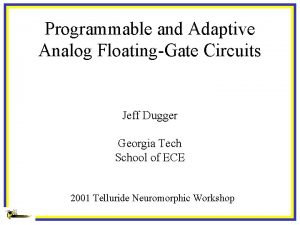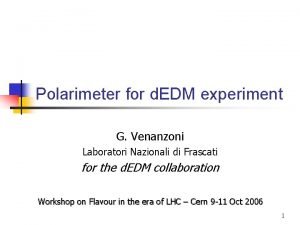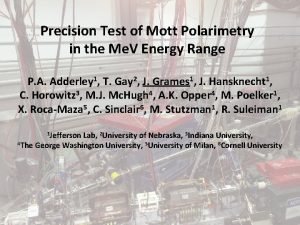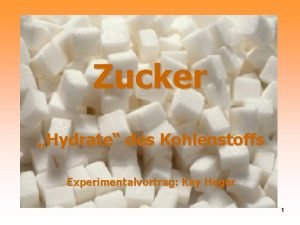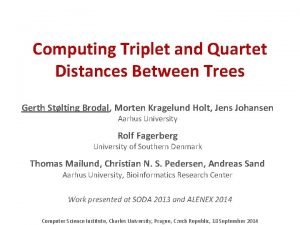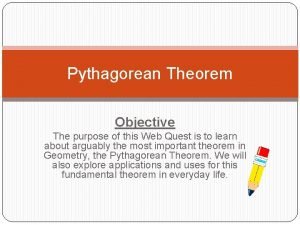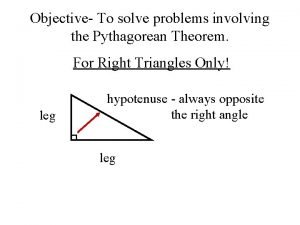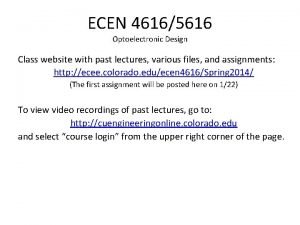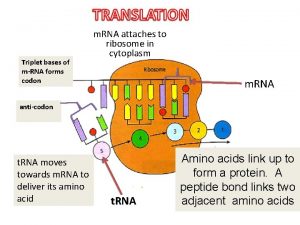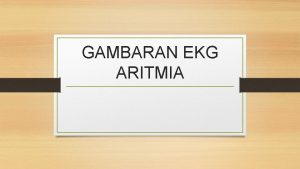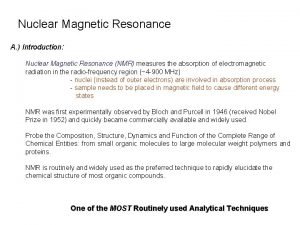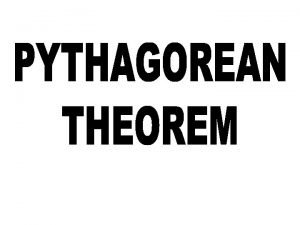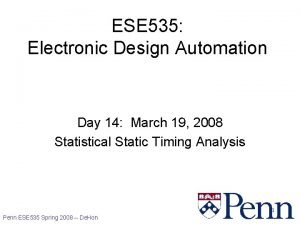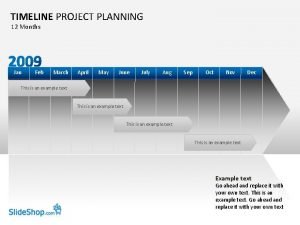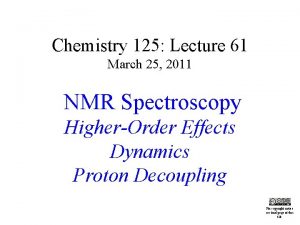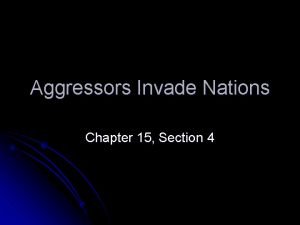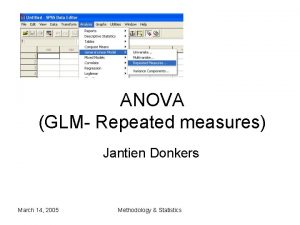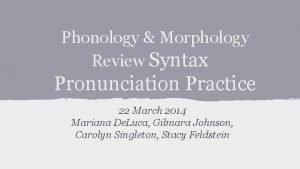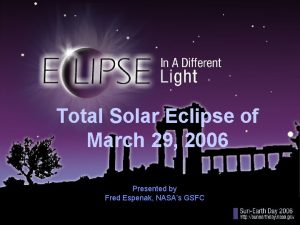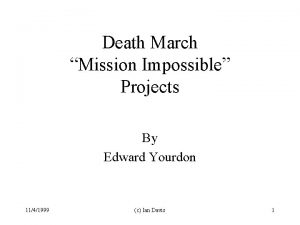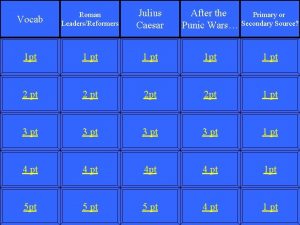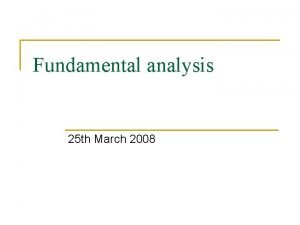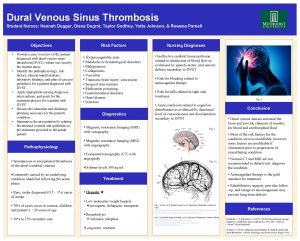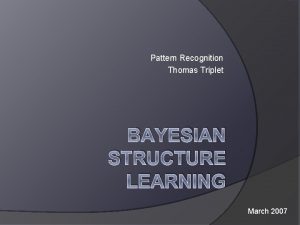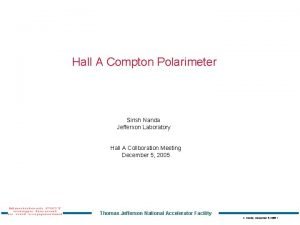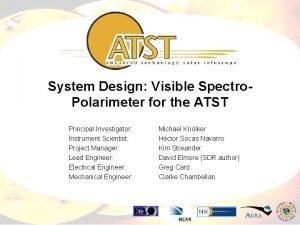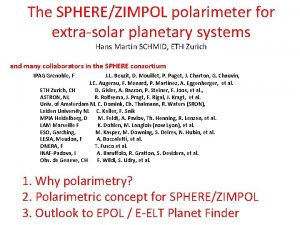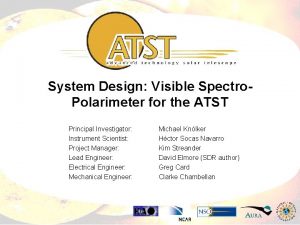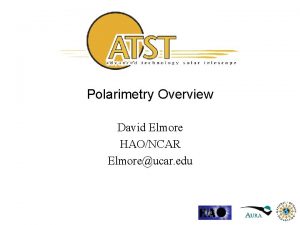Triplet polarimeter M Dugger March 2015 1 Triplet








![Most important diagrams • The Mork paper [2] says that the Compton-like diagrams and Most important diagrams • The Mork paper [2] says that the Compton-like diagrams and](https://slidetodoc.com/presentation_image_h2/77fbce1ae62215fcae74808aa8043ed8/image-9.jpg)




















![Azimuthal distribution with applied B-field • 350 gauss field applied A[1+Bcos(2φ)] A[1+Bcos(2φ)+Ccos(φ)] φ 30 Azimuthal distribution with applied B-field • 350 gauss field applied A[1+Bcos(2φ)] A[1+Bcos(2φ)+Ccos(φ)] φ 30](https://slidetodoc.com/presentation_image_h2/77fbce1ae62215fcae74808aa8043ed8/image-30.jpg)




















































- Slides: 82

Triplet polarimeter M. Dugger, March 2015 1

Triplet production • Pair production off a nucleon: γ nucleon → nucleon e+ e-. • For polarized photons σ = σ0[1 + PΣ cos(2φ)], where σ0 is the unpolarized cross section, P is the photon beam polarization and Σ is the beam asymmetry • Triplet production off an electron: γ e- → e. R- e+ e-, where e. R represents the recoil electron • Any residual momentum in the azimuthal direction of the e- e+ pair is compensated for by the slow moving recoil electron. This means that the recoil electron is moving perpendicular to the plane containing the produced pair and can attain large polar angles. M. Dugger, February 2012 2

Event generator • Diagrams used • Screening correction • Most important diagrams 3

Triplet production (pair like) 3 4 5 4 q Q 1 2 3 5 2 4 5 q 1 5 q Q 1 3 time 3 4 q Q 2 1 Q 2 • Here we have two electrons in final state and must include diagrams that have 4 ↔ 5 interchange 4

Triplet production (Compton like) 5 4 5 3 4 Q 3 time Q q 2 1 4 5 3 2 4 Q 5 q 1 1 3 Q 2 • Includes 4 ↔ 5 exchange 1 2 5

Screening correction M. Dugger, February 2014 6

Screening correction • Leonard Maximon informed me that the screening correction for triplet production should not be important for the beam asymmetry but was very important for the cross section • Used the screening correction provided in the paper by Maximon and Gimm [1] to compare cross section results of the event generator to values from the NIST [1] L. C. Maximon, H. A. Gimm Phys. Rev. A. 23, 1, (1981). 7

Comparison plot of total cross section for triplet production • Black line: Total cross section from NIST • Blue points: Total cross section from event generator without screening correction • Red points: Total cross section from event generator with screening corrections included • Very nice agreement once screening is included 8
![Most important diagrams The Mork paper 2 says that the Comptonlike diagrams and Most important diagrams • The Mork paper [2] says that the Compton-like diagrams and](https://slidetodoc.com/presentation_image_h2/77fbce1ae62215fcae74808aa8043ed8/image-9.jpg)
Most important diagrams • The Mork paper [2] says that the Compton-like diagrams and the switched electron leg diagrams should be negligible at high photon energy [2] K. J. Mork Phys. Rev. 160, 5, (1967). 9

Calculations 3 4 5 4 q 1 3 5 time q Q 1 2 Q 2 • Ran 100, 000 events at Eγ = 9. 0 Ge. V using: • Full calculation: σ = 10. 856 mb • Reduced calculation: σ = 10. 855 mb • Reduced calculation neglects Compton-like and crossed electronline diagrams • Reduced calculations are well within 0. 1% of full calculations 10

Comparison of GEANT 4 study of triplet polarimeter to previous study • The SAL detector • δ-rays • Pair to triplet ratio • ASU simulation of SAL • Could SAL have been modified to work in the Hall-D environment? M. Dugger, February 2012 11

The GW SAL detector • Eγ = 220 to 330 Me. V • 2 mm scintillator converter • Polarimeter located ~39 cm downstream of converter • Recoil θ = 15 to 35 degrees • Recoil φ = 0, 90, 180, 270 degrees with Δφ = 44 degrees • Analyzing power at the event generator level = 12% • Analyzing power from simulation 3 -4% (post experiment) • Measured analyzing power = 2. 7% • Quick check - Can ASU reproduce the GW results? M. Dugger, February 2012 12

δ-ray comparison with Iwata 1993 simulation • Eδ is δ-ray kinetic energy after traveling through 1 mm of scintillator using Iwata’s polar geometry and scintillator widths • BLUE: Current ASU GEANT 4 results • RED: Iwata GEANT 3 (scaled to GEANT 4 results by ratio of signal integration) • Shapes of the distributions look similar • ASU simulation Eγ = 300 Me. V Eδ (Me. V) • Iwata simulation Eγ = 250, 365, 450 Me. V Note: ASU simulation did not wrap scintillators M. Dugger, February 2012 13

NIST cross sections for triplet and pair production off carbon • σpair/σtriplet: 5. 75 @ 300 Me. V 5. 16 @ 9. 0 Ge. V • Ratio does not vary much over large energy range M. Dugger, February 2012 14

Comparison of ASU MC of SAL detector to GW results Note: ASU results are for Eγ = 300 Me. V and GW is of Eγ = 220 to 330 Me. V Analyzing power: • At event generator level: 12. 6 ± 0. 1 % ASU; ~12% GW (no error reported) • ASU simulation: 2. 65 ± 0. 05% • ASU simulation (30 μm Al wrapped scintillators): 2. 8 ± 0. 1 % • GW experiment: 2. 7% (no error reported) • GW simulation: 3 -4% (range given with no error reported) • ASU results are in agreement with the GW results for the SAL detector ☺ M. Dugger, February 2012 15

How could the SAL detector be modified to work in Hall-D environment? M. Dugger, February 2012 16

Dependence of analyzing power on ΔEpair for 16 sector detector • Analyzing power fairly constant for ΔEpair < 1750 Me. V • The 16 sector design increases the analyzing power to 19. 1 ± 0. 7 % from 17. 5 ± 0. 3 % of the 4 paddle design (ΔEpair < 1500 Me. V) Analyzing power (%) • Same parameters as previous best configuration but now with 16 sectors instead of 4 paddle SAL design M. Dugger, February 2012 ΔEpair (Me. V) 17

Recap of modifications that would make SAL type detector work in Hall-D M. Dugger, February 2012 18

Detector • Decided to use Micron S 3 design instead of the S 2 70 mm • The S 3 has 32 azimuthal sectors instead of 16 for the S 2 22 mm 1 mm thick 19

Preliminary design (slide 1) • Micron S 3 • Converter • 200 events thrown 20

Preliminary design (slide 2) • Micron S 3 • Converter • Mounting plate and brackets • Having a removable plate will allow for easy modification of how the detector is mounted without having to modify the chamber 21

Preliminary design (slide 3) • Micron S 3 • Converter • Mounting plate and brackets • Chamber with electrical feedthrough flange, and blank flange • Inner dimensions: 11 in by 9 in Actual design: 12 in by 12 in 22

Preliminary design (slide 4) • Includes ribbon cable from detector to electrical feedthrough 23

Preliminary design (slide 5) • With front door in see through mode • 200 events thrown 24

• Generated pairs and triplets with Eγ= 9 Ge. V • Required energy of e+ e - pair to be within 1. 75 Ge. V of each other Energy deposited (Me. V) Simulation • Required energy deposition in detector to be greater than 200 ke. V φ (degrees) • Converter: 35 μm beryllium • Used full calculation (all diagrams included) 25

• Assumed collimated photon rate in coherent peak : 99 MHz • Δt = 4 hours • Analyzing power: 0. 186 • Polarization uncertainty: 0. 01 Assumed cross section weighted counts Simulation results φ (degrees) where N ≡ Rate surviving cuts * 4 hour, P ≡ Polarization = 0. 4, and α ≡ analyzing power Rates: • Total rate on device = 955 Hz • Rate surviving software and trigger cuts = 64 Hz 26

Future home Polarimeter location (red box) • Sources of magnetic fields in red circles 27

B-field study • Study performed in April 2012 • Applied magnetic field in vertical direction 28

y (cm) Effect of B-field on δ-rays No field → y (cm) x (cm) 350 gauss field → M. Dugger, April 2012 x (cm) 29
![Azimuthal distribution with applied Bfield 350 gauss field applied A1Bcos2φ A1Bcos2φCcosφ φ 30 Azimuthal distribution with applied B-field • 350 gauss field applied A[1+Bcos(2φ)] A[1+Bcos(2φ)+Ccos(φ)] φ 30](https://slidetodoc.com/presentation_image_h2/77fbce1ae62215fcae74808aa8043ed8/image-30.jpg)
Azimuthal distribution with applied B-field • 350 gauss field applied A[1+Bcos(2φ)] A[1+Bcos(2φ)+Ccos(φ)] φ 30

Analyzing power (B) Analyzing power vs. B-field Small field → Small systematic effect Field strength (gauss) 31

Polarimeter stand in collimator cave 32

Upstream of polarimeter stand • Secondary collimator • Secondary sweep magnet • Polarimeter stand 33

Further upstream of polarimeter stand • Primary sweep magnet • Secondary collimator 34

Construction 35

Vacuum system • When the polarimeter is installed in the collimator cave, the vacuum will come from the beam line • In the test bench, the vacuum has to be provided by a temporary system • Using a rotary vane pump for the vacuum system of the test bench • Rotary vane pumps will back-stream oil and this issue must be addressed 36

Visi. Trap • Visi. Trap will catch any backstreaming before it hits the vacuum hose 37

Molecular Sieve and Stinger • Molecular sieve will catch stray contaminates • Loaded sieve with zeolite and heated for two hours 38

Vacuum system attached to chamber (view 1) • Cleaned chamber with: • Acetone • Methonal • DI water • Attached the vacuum system 39

Leakage and outgassing tests Procedure: • Pump down chamber • Close butterfly valve between vacuum system and chamber • Record the pressure as a function of time Slope = 0. 0266 m. Torr/min cycle 1 40

Vacuum leakage test results (empty chamber) • For area and volume calculations of the chamber I included all of the flanges • Volume ~ 29. 5 liters. Surface area ~ 6500 cm 2 • Outgassing rate = (Volume/Area)*d. P/dt • Tim Whitlatch said steel will outgas at a rate of 2 E-09 Torr*l/(cc*s) • It looks like the test is consistent with the d. P/dt of the chamber being from the outgassing of steel: No big obvious leaks 41

Vacuum test results (detector in chamber) • Five hour pump down to ~20 m. Torr • Ql = V*dp/dt found to be 1. 80 x 10 -4 Torr*liter/s • A turbo pump on the chamber with a flow rate of 100 liters/s with a working pressure of 2 x 10 -5 Torr will have a Qw = 2 x 10 -3 Torr*liter/s • Pfeiffer vacuum says that a system is adequately tight if Qw > 10*Ql • Putting a turbo pump with flow rate 100 liters/s on the base of the chamber should be sufficient to maintain a vacuum of 2 x 10 -5 Torr 42

Detector upstream view with source stand Po 210 source • Teflon fasteners connect detector to supports 43

Detector downstream view 44

Preamps • Decided to have a parallel development of the preamps: • Glasgow is building a pre-amplification system based off of the Rutherford Appleton Laboratory RAL-108 pramps and custom motherboards • ASU is using a pre-amplification system from Swan research (“Box 16 preamps”) 45

Swan preamps The STARS detector uses Micron S 2 with swan research preamps Stars detector Preamp hybrid Input view Output view 16 channel box 46

Preamp to feedthrough cable assembly • The Micron S 3 detector uses special ribbon cable connectors • Could not find suitable ribbon cables. Instead used Kapton wires that were individually placed in the cable connector • 40 Wires attached to connector in picture shown 47

Detector, cable and source 48

Ring side cable • Only enough preamps to instrument the sectors but made the ring side cables first 49

Preamps wired up and ground connections • Sector side cables • Ring side set to ground 50

Distribution box connected to preamp enclosure • Original distribution box 51

New distribution box (view 1) • While Kei was at ASU getting trained to be a polarimeter expert he was able to help assemble to new distribution box Signal plate 52

New distribution box (view 2) Power plate 53

Copper preamp-box grounding (slide 1) • Preamp supports made out of anodized aluminum • Decided to help ground the preamp boxes by using copper foil on the preamp supports 54

Copper preamp-box grounding (slide 2) • Lined three sides of the preamp enclosure with the copper foil • View: looking into the preamp enclosure through the opening for the vacuum chamber feedthrough flange • Ground connector to ring side of detector 55

Copper preamp-box grounding (slide 3) • View: looking into the preamp enclosure from the top • Can see the EMshielding copper mesh for the fan inlet/outlet grounded to the copper foil 56

Signal plate grounding • Cutting copper foil for the signal plate grounding • Also grounded to the input voltages (power plate) 57

Signal plate and power plate grounding 58

Fan leads • Routed the fan leads through the preamp enclosure towards the distribution box 59

View of polarimeter with original distribution box completely removed 60

Noise reduction • Wrapping signal wire around toroidal core reduces noise • Putting AC Power Entry Module (with inline filter and earth-line choke) into LV supply also helped with the noise 61

The silicon detector • The detector is very much like a diode operated in reverse bias mode • As the voltage is increased across the detector, the depletion region gets larger • The larger the depletion region, the smaller the capacitance of the detector • For each 3. 6 e. V of energy deposited in the depletion region there is one electron-hole pair that is created and then swept out of the detector 62

Noise of preamps versus input capacitance • Preamp noise has a linear relationship with the detector capacitance Typical noise versus detector capacitance plot 63

High voltage • For the test bench we are using a temporary power supply that is rather old Tennelec TC 952 • The permanent power supply will be provided by JLab and will be of higher quality • The temporary power supply has a ripple of about +/- 5 m. V at 60 Hz 64

Ripple and other noise as function of HV (slide 1) 10 m. V/div 10 ms/div HV = 0 V HV = 40 V Using Po 210 source HV = 20 V HV = 60 V 65

Ripple and other noise as function of HV (slide 2) 10 m. V/div 10 ms/div HV = 80 V HV = 100 V HV = 120 V HV = 140 V 66

Ripple and other noise as function of HV (slide 3) 10 m. V/div 10 ms/div HV = 160 V HV = 180 V α HV = 200 V 200 m. V/div & 1 µs/div 67

Alpha o-scope picture • Polonium 210 source • Alpha energy = 5. 3 Me. V • Signal about 500 m. V 68

Electron o-scope picture • Cesium 137 source • Signal about 25 m. V for this shot • Finer time scale for this shot (50 ns/div) 69

Data acquisition system at ASU • Using a Tektronix logging oscilloscope as a slow ADC • Acquisition rate ~ 1 Hz Lab. View signal express GUI 70

Fit to signal • Assume voltage has same form V = [Γr Vm/(Γr - Γf)][exp(Γrt) – exp(Γrt)] Voltage Po 210 signal time (μs) 71

• Po 210 alpha source Counts Calibration (sector 3) Center = 505. 5 m. V • Ek = 5304. 33 ke. V • One hour of data m. V • Calculated sensitivity = 95 m. V/Me. V 72

Alpha-test widths • Looked at all 32 sectors • Looks good except for a single channel (sector 32, lower preamp-box channel 10) 73

Voltage Typical fit to signal for Ba 133 source time (μs) 74

Ba 133 MC compared to data (sector 3) MC • MC • Generated photon energies: 223, 276, 302, 356, 383 ke. V • • • Data Smeared energy deposited by standard deviation of 12 ke. V Fit: • Centers locked to same photon energies that were generated in MC • Standard deviation was the same for each Gaussian and allowed to vary • Standard deviation from fit found to be 11+/- 1 ke. V Therefore, resolution of detector plus electronics is about 12 ke. V for this sector 75

Pile-up study • Threw 10 million photon events • Only 469 events seen on detector • Assume • 108 Hz in photon range between 8. 4 and 9 Ge. V • Timing window of preamp pulse to be 18 μs • For a single sector we expect 0. 7% of events to have more than one signal in the timing window • Pile-up should not be much of an issue 2. 1% of total 76

Work still to be done at ASU • Need to complete the positioning system (should be able to finish this week) 77

Convertor tray Top of converter tray Bottom of converter tray 78

Positioning system • Still need to clean parts and install limit switches • I expect the positioning system to be ready to ship by the end of this week 79

Chamber crated up 80

Initial work to be done at JLab • Set up the chamber with vacuum system attached and do leakage and outgassing tests • Attach the preamps and make sure that the signals look as they did at ASU • Send the signals through the f. ADC and take data • Attach the position control system and test New stuff 81

Chamber at JLab Chamber • JLab started receiving the polarimeter parts last week • Initial test bench in the Experimental Equipment Laboratory (EEL) at Jefferson Lab 82
 Jeff dugger
Jeff dugger Anthem of poland
Anthem of poland Polarimeter
Polarimeter Mott polarimeter
Mott polarimeter Glycosidebinding
Glycosidebinding Triplet of quartets
Triplet of quartets Singlet doublet
Singlet doublet Geometry triples
Geometry triples Septet stanza
Septet stanza Is 5 12 13 a pythagorean triplet
Is 5 12 13 a pythagorean triplet Rhyming words for limerick poems
Rhyming words for limerick poems End rhyme
End rhyme Limerick there once was an ape in a zoo
Limerick there once was an ape in a zoo Cooke triplet
Cooke triplet Triplet of bases on mrna
Triplet of bases on mrna Refrain definition literature
Refrain definition literature R on t
R on t Larmor frequency nmr
Larmor frequency nmr B = 9, c = 16 a =
B = 9, c = 16 a = Point of view
Point of view Triplet poem
Triplet poem Glasgow 5th march 1971
Glasgow 5th march 1971 March madness banner
March madness banner Evening standard cartoon
Evening standard cartoon March identifier clips
March identifier clips 535 before 14 march
535 before 14 march What is ngo?
What is ngo? Slice march
Slice march Sherman's march to the sea
Sherman's march to the sea Poem for 8 march
Poem for 8 march Current events quiz
Current events quiz March 1917 revolution
March 1917 revolution Jan feb march
Jan feb march March 5 2021
March 5 2021 Source
Source March 25 2011
March 25 2011 Chapter 15 section 4 aggressors on the march
Chapter 15 section 4 aggressors on the march Salt march
Salt march Glasgow 5th march
Glasgow 5th march Path of sherman's march to the sea
Path of sherman's march to the sea January february march season
January february march season Glm repeated measures spss
Glm repeated measures spss March verb
March verb Grihalakshmi magazine march 2019
Grihalakshmi magazine march 2019 Why is the long march important
Why is the long march important Texas revolution battles map
Texas revolution battles map March 7, 2012
March 7, 2012 Sigma gamma rho march of dimes
Sigma gamma rho march of dimes Astronomy picture of the day march 29 2006
Astronomy picture of the day march 29 2006 Performance art
Performance art Death march edward yourdon
Death march edward yourdon Civil war map sherman's march to the sea
Civil war map sherman's march to the sea March 30 1981
March 30 1981 Offset printing march
Offset printing march Game data crunch
Game data crunch Glorious mystery
Glorious mystery Ides of march punic wars
Ides of march punic wars Abraham lincoln
Abraham lincoln Jan rose kasmir
Jan rose kasmir March kindergarten newsletter
March kindergarten newsletter Ohio become a state
Ohio become a state Isinulong niya ang pagkakaisa ng mga tsino
Isinulong niya ang pagkakaisa ng mga tsino There's a royal banner given for display
There's a royal banner given for display Inurl:bug bounty intext:token of appreciation
Inurl:bug bounty intext:token of appreciation 25 march 2008
25 march 2008 Glasgow 5th march 1971
Glasgow 5th march 1971 March 2013
March 2013 Mist tccc
Mist tccc Rizal left london and went to paris.
Rizal left london and went to paris. March 7 2008
March 7 2008 Where was vincent van gogh born
Where was vincent van gogh born March 23 world meteorological day
March 23 world meteorological day Bingo bins mortdale
Bingo bins mortdale March algorthym
March algorthym Drill and ceremony commands
Drill and ceremony commands Trade discount
Trade discount March 22 2010
March 22 2010 Grade 10 life science transpiration practical
Grade 10 life science transpiration practical Hemosiderinüri nedir
Hemosiderinüri nedir Celebrated on march 17
Celebrated on march 17 March 14 445 bc
March 14 445 bc Iron curtain cartoon
Iron curtain cartoon Sherman's march significance
Sherman's march significance
